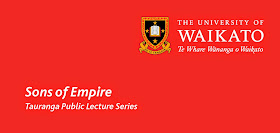 |
The Strand, Tauranga, looking south, c. 1910s, showing two of the three hotels (the Commercial and the Masonic)
Image courtesy of Tauranga City Library, Ref. 99-70 |
On 16 October 2007, the Bay of Plenty Times reported that the Tauranga City Council was preparing a night management plan to curb brawling and drunkenness on the Strand. In the 19th century also, the typical Strand crime was being drunk and disorderly: as there were three pubs in less than 300 metres, this can be no surprise. In the 1870s the long-suffering Constable Thomas Whelan dealt with an endless string of drunks, who were brought before the magistrate and fined five shillings plus costs for a first offence, or 24 hours in Tauranga jail if they failed to pay up. For subsequent offences they would be stung for ten shillings (or 48 hours in jail). This was the fine paid by Eliza Rudd of Greerton, when she was caught for the second time in less than a month in 1878.
The use of obscene language was usually punished more sharply, though Joseph Faulkner in 1877 was let off with a nominal fine of one shilling. Not so Tuwhiti, a Maori, who in the same year had to pay a whole pound plus 15 shillings costs or endure seven days’ hard labour.
 |
The Strand c. 1883, with a number of ‘loafers’
Image courtesy of Tauranga City Library, Ref. 04-250 | |
Maori names were conspicuous among the drinkers, and there were sanctimonious comments about this from Pakeha. ‘We are sorry to see so much drunkenness among the natives now in Tauranga; it is almost impossible to walk along the Strand at any hour without meeting one or two intoxicated aborigines’ (Bay of Plenty Times, 21 August 1878). The impact of alcohol on Maori communities was already serious in the 1870s (1), and Maori leaders expressed concerned about it. But since drinking dulled the pain caused by loss of land and mana, it was difficult to stop – especially when there were so many pubs.
Other offences were reported: thefts and assaults; exploding dynamite in the harbour; and traffic violations, such as riding a horse too fast or on the footpath. Te Kani was fined five shillings and costs for ‘furious riding’ in June 1877. In November of the same year, George Grant was charged with a curious breach of the Municipal Police Act, i.e. tying a rope across the Strand near Wharf Street. He denied the charge, which was dismissed.
 |
Commercial Hotel c 1912, before it burned down in 1916
Image courtesy of Tauranga City Library, Ref. 99-723 |
Although most crime on the Strand was at the lower end of the scale, there was one sad exception. In February 1892 Duncan Munro was found wandering there half-naked, singing hymns and covered in blood, after bludgeoning his wife and children to death. Munro had shown evidence of mental disturbance for some time and was found not guilty of murder by reason of insanity. He was taken to the Whau Lunatic Asylum in Auckland.
Excessive strolling along the Strand, although not a crime, was deplored by the Bay of Plenty Times. It was the mark of the unemployed, who were advised in 1876 to stop ‘loafing about the Strand’ and go up to Poripori to prospect for gold; or of the lazy, like those members of the Jockey Club who allegedly spent their time ‘talking horse and smoking infamous cigars’ instead of setting up a racecourse. Captain Hannibal Marks the harbour master, also frequently seen on the Strand, was in October 1878 accused of similar neglect of his duties. This is probably what led a few days later to Pascoe Spriddle Marks’ being charged with using threatening language (‘to wit, “I’ll give that d-----d little skunk of an Editor a b-----y good thrashing”’) to Alfred Stewart Rathbone, Editor of the Bay of Plenty Times. The threat was uttered on the Strand, where the editor must have spent quite a bit of time himself.
Being threatened with violence on the Strand seems to have been an occupational hazard for editors of the Times. John Chadwick was charged with using threatening and abusive language to E. M. Edgcumbe in 1876 when the latter was editor. Mr Chadwick apparently said, ‘”You low-looking blackguard, I’ll teach you to put my name in the paper; I’ll make Tauranga so hot for you you’ll have to clear out”’, and ‘”You b-----y wretch, I’ll warm you yet”’ – this last being said ‘in a low hissing sort of voice, with the defendant’s fist lifted towards [Mr Edgcumbe’s] face’. In January 1877 Henry Sheldon used obscene language, lit matches and threw them about, ‘and threatened to punch the head of the Editor of the Bay of Plenty Times’: ten shillings’ fine plus costs of 6s 6d. The newspaper’s more recent editors may feel themselves lucky to have escaped such dramas – but then they probably spend less time on the Strand than their predecessors did.
(1) Megan Cook. '
Māori smoking, alcohol and drugs – tūpeka, waipiro me te tarukino - Māori use of alcohol', Te Ara - the Encyclopedia of New Zealand, updated 30-Jun-14
URL: http://www.TeAra.govt.nz/en/maori-smoking-alcohol-and-drugs-tupeka-waipiro-me-te-tarukino/page-2

















































